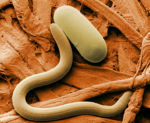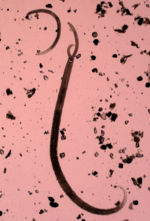Difference between revisions of "Nematodes"
m (Unprotected "Nematodes") |
|||
| (6 intermediate revisions by one other user not shown) | |||
| Line 1: | Line 1: | ||
| − | + | {unfinished} | |
| + | |||
| + | == Introduction == | ||
| + | [[Image:Soybean cyst nematode EM.jpg|thumb|right|150px|Soybean Cyst Nematode and Egg, Scanning Electron Micrograph - Wikimedia Commons]] | ||
| + | [[Image:Mononchidae eating a Mononchidae.jpg|thumb|right|150px|Mononchidae eating a Mononchidae - Wikimedia Commons]] | ||
| + | Nematodes are one of the most prolific life-forms on this planet. Most are free-living, with species adapted to every imaginable habitat. Some are parasitic on plants, and others on animals. The animal parasitic nematodes form a large and diverse array of organisms. | ||
| + | |||
| + | == The Nematodes == | ||
| + | === Recognition Features === | ||
| + | *A unique feature of the nematodes is that the fluid in the body cavity is maintained under high pressure (this is why nematodes often burst after collection) | ||
| + | *They therefore have a tough elastic cuticle which often forms elaborate structures useful for identification | ||
| + | *A muscular pharynx is needed to pump food into the intestine | ||
| + | *The shape of the pharynx is characteristic in some groups | ||
| + | *There is a nerve ring around the pharynx and four longitudinal nerves with ganglia that co-ordinate movement (many anthelmintics act by disrupting neuromuscular co-ordination) | ||
| + | *The sexes are separate: | ||
| + | **the female tail generally ends in a blunt point | ||
| + | **males usually have two chitinous rods that can be protruded through the cloaca to hold the female - these are called spicules and, being chitinous, are easily seen under the microscope. As these differ in shape and size between species, they are very useful in identification | ||
| + | *The '''bursate nematodes''' are characterised by a large expansion of the cuticle of the male tail to form a clasping organ (the bursa) | ||
| + | *Other modifications of the cuticle on both male and female nematodes useful for identification include: | ||
| + | **'''alae''' (wing-like protrusions) | ||
| + | **'''vesicles''' (swellings around the whole circumference of the body) | ||
| + | *The heads of some nematodes have structures such as: | ||
| + | **leaf-like lips around the mouth (the '''leaf-crown''') | ||
| + | **a '''buccal cavity''' | ||
| + | **'''teeth''' or '''cutting plates''' | ||
| + | |||
| + | === Feeding Habits === | ||
| + | *Many intestinal nematodes are closely applied to the mucosal surface | ||
| + | *Some swallow ingesta and/or host secretions. | ||
| + | *Others suck a plug of mucosa into the buccal cavity (plug feeders), leaving a circular ulcer | ||
| + | *Yet others bury their heads deep into the mucosa and suck blood | ||
| + | |||
| + | === General Life-Cycle === | ||
| + | *The basic life-cycle is very simple: | ||
| + | **egg → L1 → L2 → L3 → L4 → adult | ||
| + | *With a moult in between each larval stage | ||
| + | *But there are many variations on this theme | ||
| + | |||
| + | === Nematode Eggs === | ||
| + | *These vary greatly in appearance and are very useful for diagnosis as they can often be detected and counted in faecal samples | ||
| + | *NOTE: we use the typical '''strongyle''' egg to provide us with a yard-stick for comparing sizes. A "large egg", for example, means larger than a strongyle egg. A typical strongyle egg is approximately '''80µm''' long | ||
| + | |||
| + | == Nematode Superfamilies == | ||
| + | |||
| + | <big> | ||
| + | |||
| + | [[:Category:Bursate Nematodes|'''BURSATE''']] | ||
| + | |||
| + | *[[Trichostrongyloidea]] | ||
| + | |||
| + | *[[Strongyloidea]] | ||
| + | |||
| + | *[[Ancylostomatoidea]] (Hook worms) | ||
| + | |||
| + | *[[Metastrongyloidae]]</big> | ||
| + | |||
| + | NOTE: the Trichostrongyloidea, Strongyloidea and hookworms are very closely related, and are often collectively known as '''"the strongyles"'''. Typically, they produce almost identical eggs, called '''"typical strongyle eggs"'''. | ||
| + | |||
| + | <big>[[:Category:Non-bursate Nematodes|'''NON-BURSATE''']] | ||
| + | |||
| + | *[[Ascaridoidea]] | ||
| + | |||
| + | *[[Oxyuroidea]] | ||
| + | |||
| + | *[[Rhabditoidea]] | ||
| + | |||
| + | *[[Trichinelloidea]] | ||
| + | |||
| + | *[[Spiruroidea]] | ||
| + | |||
| + | *[[Filarioidea]]</big> | ||
| + | |||
| + | From the veterinary view-point, the nematodes are most conveniently grouped into '''superfamilies''' because their members often have similar life-cycles and epidemiological features. Superfamily names end in -oidea (the anglicised form is -oid, as in trichostrongyloid). | ||
| + | |||
| + | == Nematodes of Different Species == | ||
| + | [[Cattle]] [[:Category:Cattle Nematodes]] | ||
| + | |||
| + | [[Small Ruminants]] | ||
| + | |||
| + | [[Horses]] | ||
| + | |||
| + | [[Pigs]] | ||
| + | |||
| + | [[Poultry]] | ||
| + | |||
| + | [[Small Animals]] | ||
| + | |||
| + | [[Endoparasites - Donkey|Donkey]] | ||
| + | |||
| + | |||
| + | |||
| + | |||
| + | |||
| + | Occlusion of pancreatic ducts sometimes happens [[Pancreas Parasitic - Pathology]] | ||
Revision as of 13:13, 20 April 2010
{unfinished}
Introduction
Nematodes are one of the most prolific life-forms on this planet. Most are free-living, with species adapted to every imaginable habitat. Some are parasitic on plants, and others on animals. The animal parasitic nematodes form a large and diverse array of organisms.
The Nematodes
Recognition Features
- A unique feature of the nematodes is that the fluid in the body cavity is maintained under high pressure (this is why nematodes often burst after collection)
- They therefore have a tough elastic cuticle which often forms elaborate structures useful for identification
- A muscular pharynx is needed to pump food into the intestine
- The shape of the pharynx is characteristic in some groups
- There is a nerve ring around the pharynx and four longitudinal nerves with ganglia that co-ordinate movement (many anthelmintics act by disrupting neuromuscular co-ordination)
- The sexes are separate:
- the female tail generally ends in a blunt point
- males usually have two chitinous rods that can be protruded through the cloaca to hold the female - these are called spicules and, being chitinous, are easily seen under the microscope. As these differ in shape and size between species, they are very useful in identification
- The bursate nematodes are characterised by a large expansion of the cuticle of the male tail to form a clasping organ (the bursa)
- Other modifications of the cuticle on both male and female nematodes useful for identification include:
- alae (wing-like protrusions)
- vesicles (swellings around the whole circumference of the body)
- The heads of some nematodes have structures such as:
- leaf-like lips around the mouth (the leaf-crown)
- a buccal cavity
- teeth or cutting plates
Feeding Habits
- Many intestinal nematodes are closely applied to the mucosal surface
- Some swallow ingesta and/or host secretions.
- Others suck a plug of mucosa into the buccal cavity (plug feeders), leaving a circular ulcer
- Yet others bury their heads deep into the mucosa and suck blood
General Life-Cycle
- The basic life-cycle is very simple:
- egg → L1 → L2 → L3 → L4 → adult
- With a moult in between each larval stage
- But there are many variations on this theme
Nematode Eggs
- These vary greatly in appearance and are very useful for diagnosis as they can often be detected and counted in faecal samples
- NOTE: we use the typical strongyle egg to provide us with a yard-stick for comparing sizes. A "large egg", for example, means larger than a strongyle egg. A typical strongyle egg is approximately 80µm long
Nematode Superfamilies
- Ancylostomatoidea (Hook worms)
NOTE: the Trichostrongyloidea, Strongyloidea and hookworms are very closely related, and are often collectively known as "the strongyles". Typically, they produce almost identical eggs, called "typical strongyle eggs".
From the veterinary view-point, the nematodes are most conveniently grouped into superfamilies because their members often have similar life-cycles and epidemiological features. Superfamily names end in -oidea (the anglicised form is -oid, as in trichostrongyloid).
Nematodes of Different Species
Cattle Category:Cattle Nematodes
Occlusion of pancreatic ducts sometimes happens Pancreas Parasitic - Pathology

